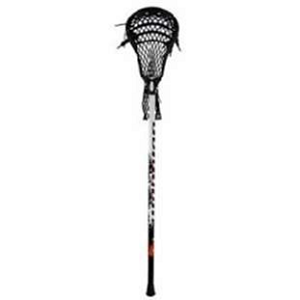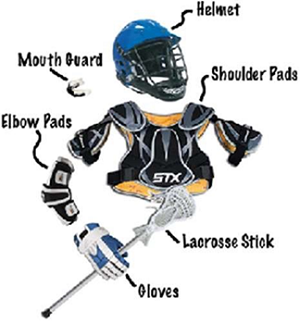Lacrosse – Equipment
The long crosse and the crosse for a goalkeeper
Players can carry a long crosse (also called the d-pole) which is 52 inches to 72 inches in length. These long crosse are used typically by defenders and midfielders. For the players, the head part of the crosse must be 6.5 inches at its broadest point and the throat part of the crosse must be at least 3 inches wide.
The goalkeeper has to use a crosse which is 42 inches to 72 inches in length and the head can be up to 12 inches which is larger than the ones used by the other players, mainly to catch the ball and/or defend it.

The Lacrosse Sticks and Stick heads
Basically, there are 3 parts in every lacrosse stick head – the scoop, sidewall and the pocket. The scoop of a crosse is the top of the stick that helps in picking up the balls from the ground and passing and/or shooting the ball.
The scoop can either be of a flat shape for easier pick up or more of a U shape for better control of the ball while fast movements.
Both of these have their advantages and disadvantages, where a flatter scoop helps in picking up the ball from the ground but makes it difficult to keep it on the head while a U shaped scoop makes it difficult to pick up the ball but helps in keeping the ball with accuracy.
The sidewall is the side part of the head that makes its depth and stiffness. Stiffer sidewalls and heads are better used for defending in order to throw better checks. Flexible sidewalls are better to be used for groundballs, face-offs and faster movements.
The pocket of the head is the mesh including the width of the head at the basal part. A wider pocket helps in catching the ball but reduces the control over the ball. A narrower pocket makes catching difficult but increases control of the ball and accuracy.
Types of Shafts
Shaft is another part of the lacrosse stick which is of various types. Attackers use lighter shaft to move the ball quickly whereas the defenders use the heavy shaft to prevent the throws made by the attacker. The different types of shafts are as follows −
-
Aluminum alloy shafts − These shafts are strong, lightweight, and good for developing players.
-
Composite shafts − These are stronger and lighter than aluminum ones with solid grip. These are good for intermediate and elite players.
-
Titanium shafts − These are strong and light and are good for both receiving and delivering checks.
-
Scandium shafts − These have the highest strength-weight ratio out of all the sticks and are much more durable.
-
Wooden shafts − These are strong, but heavy and tough to bend. These are good for delivering hard checks.
-
Bamboo shafts − These are heavy and can be easily broken. These are good for delivering painful checks.
Protective Equipment
All the players on the field have to wear a uniform with a number that is unique to them and the shorts should be matching to the players of the same team. The number on the uniform can be any single digit number or any two-digit number between 1 and 99.

We have already discussed about the crosse and the ball. So let’s get into detail about the protective equipment. The protective equipment is standardized for all the players except the goalkeepers. The standard equipment for the players is as follows −
- A helmet with mouth guard and chin strap
- Shoulder pads
- Arm pads
- Gloves
Goalkeeper’s Equipment
The goalkeepers need to have the following equipment −
-
Helmet with mouth guard, a chin strap and throat guard which covers the neck.
-
Chest protector
-
Gloves
Goalkeepers can wear pants; other players need to wear shorts. Although it’s not technically required, but a protective cup for the crotch is highly recommended for all the players regardless of the position.
